SNAPScapes: Using Geodemographic Segmentation to Classify the Food Access Landscape
Abstract
1. Introduction
2. Previous Studies and Background
2.1. Food Access
2.2. Geodemographic Segmentation
3. Data and Methods
3.1. Data
3.2. Methods
3.2.1. Data Pre-Processing
3.2.2. k-Means Analysis
4. Results and Discussion
Cluster Mapping and Food Desert Comparison
5. Conclusions
Author Contributions
Funding
Conflicts of Interest
References
- Peralta, K.; Off, G. Charlotte’s Grocery Wars Leave Poor Neighborhoods behind. The Charlotte Observer, 16 March 2017. Available online: https://www.charlotteobserver.com/news/business/article138771028.html (accessed on 28 April 2017).
- Raja, S.; Changxing, M.; Yadav, P. Beyond Food Deserts: Measuring and Mapping Racial Disparities in Neighborhood Food Environments. J. Plan. Educ. Res. 2008, 27, 469–482. [Google Scholar] [CrossRef]
- Richardson, A.S.; Meyer, K.A.; Howard, A.G.; Boone-Heinonen, J.; Popkin, B.M.; Evenson, K.R.; Kiefe, C.I.; Lewis, C.E.; Gordon-Larsen, P. Neighborhood Socioeconomic Status and Food Environment: A 20-Year Longitudinal Latent Class Analysis among CARDIA Participants. Health Place 2014, 11, 145–153. [Google Scholar] [CrossRef] [PubMed]
- USDA. Food Access Research Atlas. Available online: https://www.ers.usda.gov/data-products/food-access-research-atlas/ (accessed on 8 August 2018).
- Gallagher, M. USDA defines food deserts. Nutr. Dig. 2011, 38. Available online: http://americannutritionassociation.org/newsletter/usda-defines-food-deserts (accessed on 11 April 2017).
- Widener, M.J.; Farber, S.; Neutens, T.; Horner, M.W. Using Urban Commuting Data to Calculate a Spatiotemporal Accessibility Measure for Food Environment Studies. Health Place 2013, 21, 1–9. [Google Scholar] [CrossRef] [PubMed]
- Horner, M.W.; Wood, B.S. Capturing Individuals’ Food Environments Using Flexible Space-Time Accessibility Measures. Appl. Geogr. 2014, 51, 99–107. [Google Scholar] [CrossRef]
- Farber, S.; Morang, M.; Widener, M.J. Temporal Variability in Transit-Based Accessibility to Supermarkets. Appl. Geogr. 2014, 53, 149–159. [Google Scholar] [CrossRef]
- Widener, M.J.; Minaker, L.; Farber, S.; Allen, J.; Vitali, B.; Coleman, P.; Cook, B. How do changes in the daily food and transportation environments affect grocery store accessibility? Appl. Geogr. 2017, 83, 46–62. [Google Scholar] [CrossRef]
- Shannon, J.; Christian, W.J. What Is the Relationship between Food Shopping and Daily Mobility? A Relational Approach to Analysis of Food Access. GeoJournal 2017, 82, 769–785. [Google Scholar]
- LeClair, M.S.; Aksan, A.-M. Redefining the Food Desert: Combining GIS with Direct Observation to Measure Food Access. Agric. Hum. Values 2014, 31, 537–547. [Google Scholar]
- Mabli, J.; Worthington, J. The Food Access Environment and Food Purchase Behavior of SNAP Households. J. Hunger Environ. Nutr. 2015, 10, 132–149. [Google Scholar] [CrossRef]
- Ghirardelli, A.; Quinn, V.; Foerster, S. Using Geographic Information Systems and Local Food Store Data in Califorinia’s Low-Income Neighborhoods to Inform Community Initiatives and Resources. Am. J. Public Health 2010, 100, 2156–2162. [Google Scholar] [CrossRef] [PubMed]
- Bridle-Fitzpatrick, S. Food Deserts or Food Swamps?: A Mixed-Methods Study of Local Food Environments in a Mexican City. Soc. Sci. Med. 2015, 142, 202–213. [Google Scholar] [CrossRef] [PubMed]
- Andrews, M.; Smallwood, D. What’s Behind the Rise in SNAP Participation? Amber Waves 2012, 10, 1–6. [Google Scholar]
- Kaufman, P.R. Rural Poor Have Less Access to Supermarkets, Large Grocery Stores. Rural Dev. Perspect. 1999, 13, 19–26. [Google Scholar]
- Zenk, S.N.; Schulz, A.J.; Israel, B.A.; James, S.A.; Bao, S.; Wilson, M.L. Neighborhood Racia Composition, Neighborhood Poverty, and the Spatial Accessibility of Supermarkets in Metropolitan Detroit. Am. J. Public Health 2005, 95, 660–667. [Google Scholar] [CrossRef] [PubMed]
- Shannon, J. What Does SNAP Benefit Usage Tell Us about Food Access in Low-Income Neighborhoods? Soc. Sci. Med. 2014, 107, 89–99. [Google Scholar] [CrossRef] [PubMed]
- Racine, E.F.; Delmelle, E.; Major, E.; Solomon, C.A. Accessibility Landscapes of Supplemental Nutrition Assistance Program−Authorized Stores. J. Acad. Nutr. Diet. 2018, 118, 836–848. [Google Scholar] [CrossRef] [PubMed]
- Widener, M.J.; Li, W. Using Geolocated Twitter Data to Monitor the Prevalence of Healthy and Unhealthy Food References across the US. Appl. Geogr. 2014, 54, 189–197. [Google Scholar] [CrossRef]
- Kwan, M.P. Gender and individual access to urban opportunities: A study using space-time measures. Prof. Geogr. 1999, 51, 210–227. [Google Scholar] [CrossRef]
- Sleight, P. Targeting Customers: How to Use Geodemographic and Lifestyle Data in Your Business, 2nd ed.; NTC Publications: Henley-on-Thames, UK, 1997. [Google Scholar]
- Burrows, R.; Gane, N. Geodemographics, Software and Class. Sociology 2006, 40, 793–812. [Google Scholar] [CrossRef]
- Harris, R.; Sleight, P.; Webber, R. Geodemographics, GIS and Neighbourhood Targeting; John Wiley and Sons: Hoboken, NJ, USA, 2005. [Google Scholar]
- Dibb, S.; Simkin, L. Bridging the Segmentation Theory/Practice Divide. J. Mark. Manag. 2010, 25, 219–225. [Google Scholar] [CrossRef]
- Petersen, J.; Gibin, M.; Longley, P.; Mateos, P.; Atkinson, P.; Ashby, D. Geodemographics as a Tool for Targeting Neighbourhoods in Public Health Campaigns. J. Geogr. Syst. 2011, 13, 173–192. [Google Scholar] [CrossRef]
- Hamano, T.; Fujisawa, Y.; Ishida, Y.; Subramanian, S.V.; Kawachi, I.; Shiwaku, K. Social Capital and Mental Health in Japan: A Multilevel Analysis. PLoS ONE 2010, 5, e13214. [Google Scholar] [CrossRef] [PubMed]
- Grubesic, T.H.; Miller, J.; Murray, A.T. Geospatial and Geodemographic Insights for Diabetes in the United States. Appl. Geogr. 2014, 55, 117–126. [Google Scholar] [CrossRef]
- Delmelle, E.C. Five decades of neighborhood classifications and their transitions: A comparison of four US cities, 1970–2010. Appl. Geogr. 2015, 57, 1–11. [Google Scholar] [CrossRef]
- United States Census Bureau. American Community Survey. Available online: https://www.census.gov/programs-surveys/acs (accessed on 8 August 2018).
- Spielman, S.; Folch, D.; Nagle, N. Patterns and causes of uncertainty in the American Community Survey. Appl. Geogr. 2014, 46, 147–157. [Google Scholar] [CrossRef] [PubMed]
- Spielman, S.E.; Singleton, A. Studying neighborhoods using uncertain data from the American community survey: A contextual approach. Ann. Am. Assoc. Geogr. 2015, 105, 1003–1025. [Google Scholar] [CrossRef]
- Nanetti, L.; Cerliani, L.; Gazzola, V.; Renken, R.; Keysers, C. Group Analyses of Connectivity-Based Cortical Parcellation Using Repeated K-Means Clustering. NeuroImage 2009, 47, 1666–1677. [Google Scholar] [CrossRef] [PubMed]
- Skikit-learn. Scikit-learn-Machine Learning in Python. Available online: http://scikit-learn.org/stable/ (accessed on 8 August 2018).
- Zaki, M.J.; Meira, W., Jr.; Meira, W. Data Mining and Analysis: Fundamental Concepts and Algorithms; Cambridge University Press: Cambridge, UK, 2014. [Google Scholar]

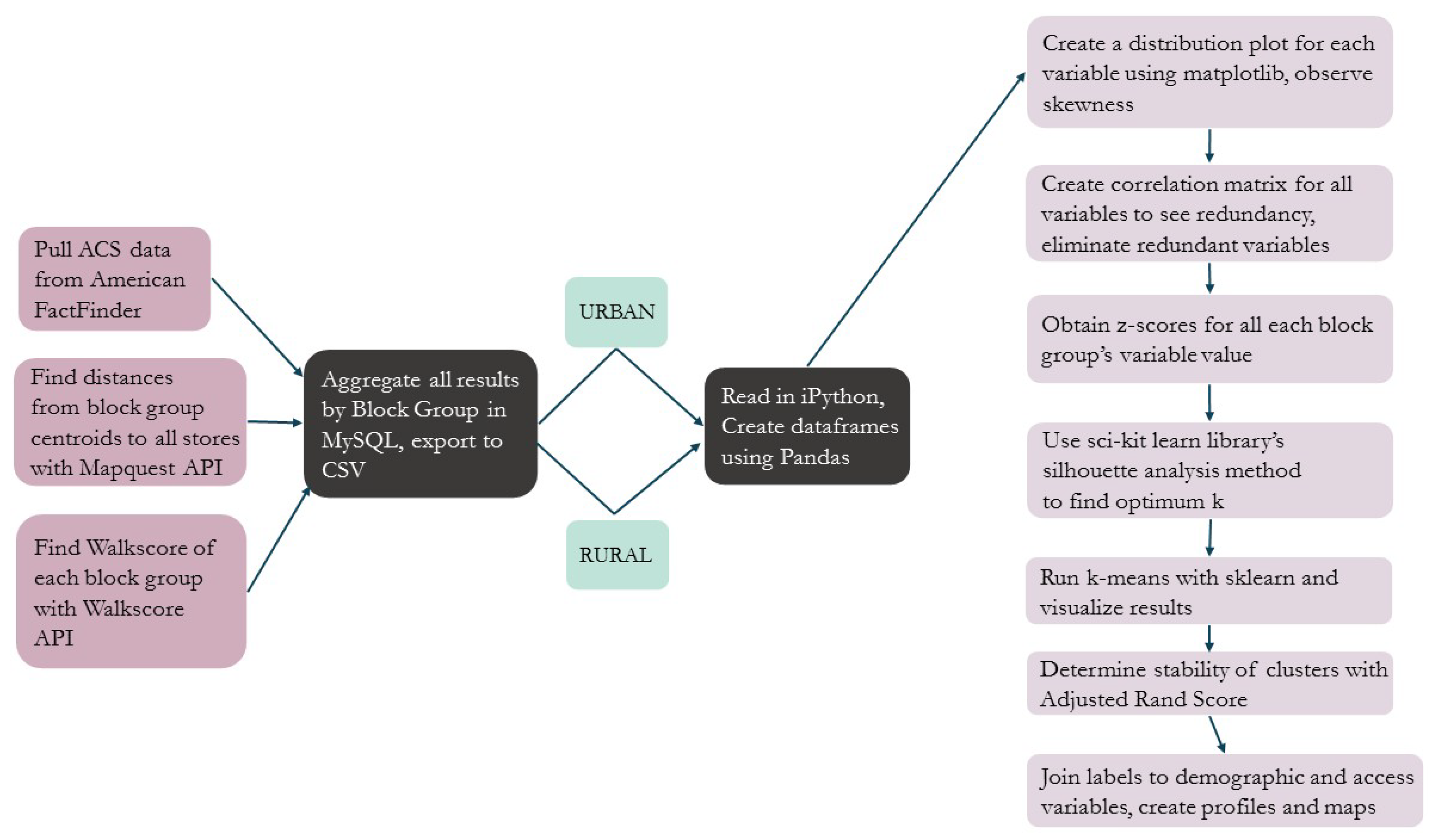
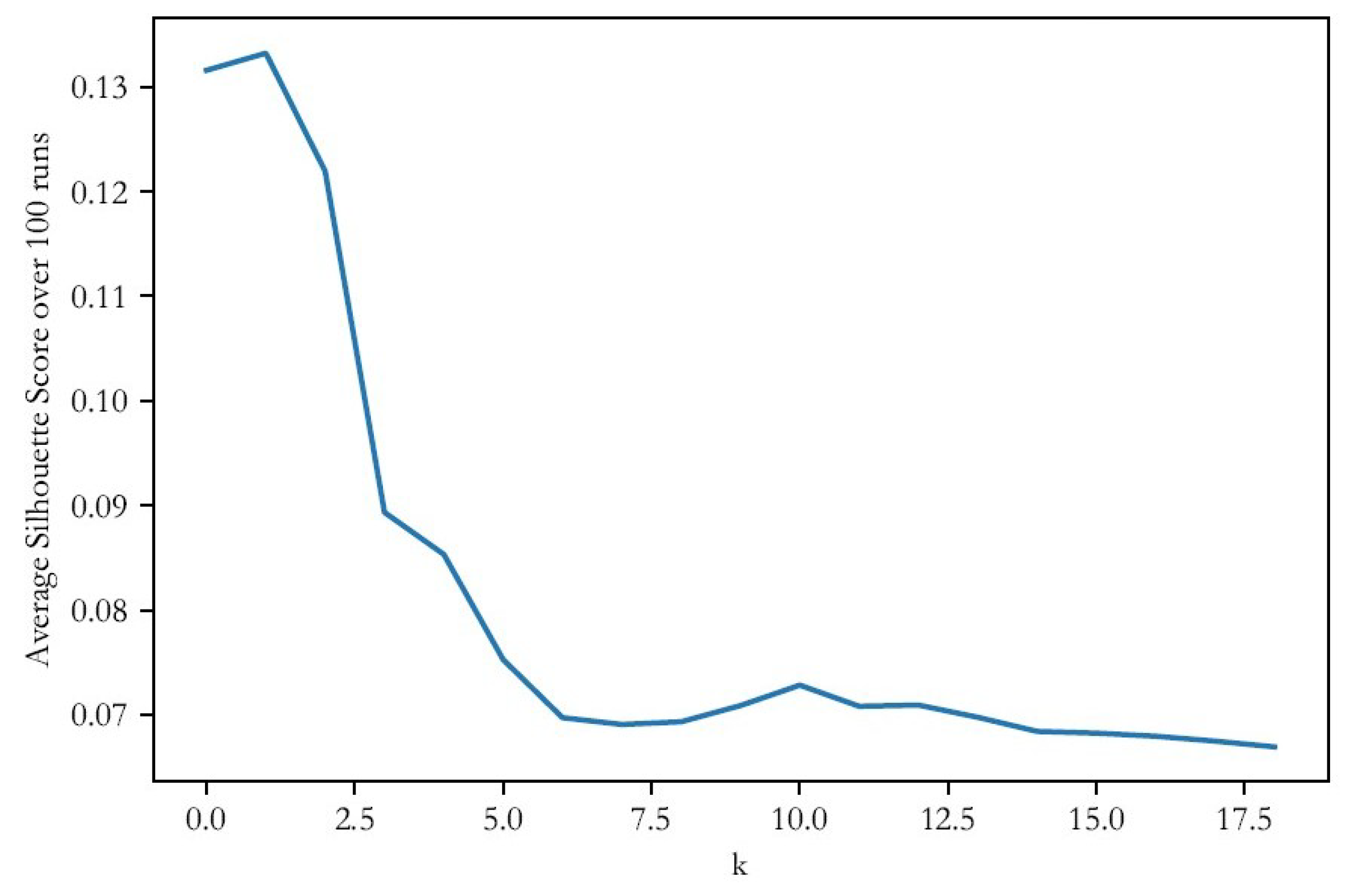
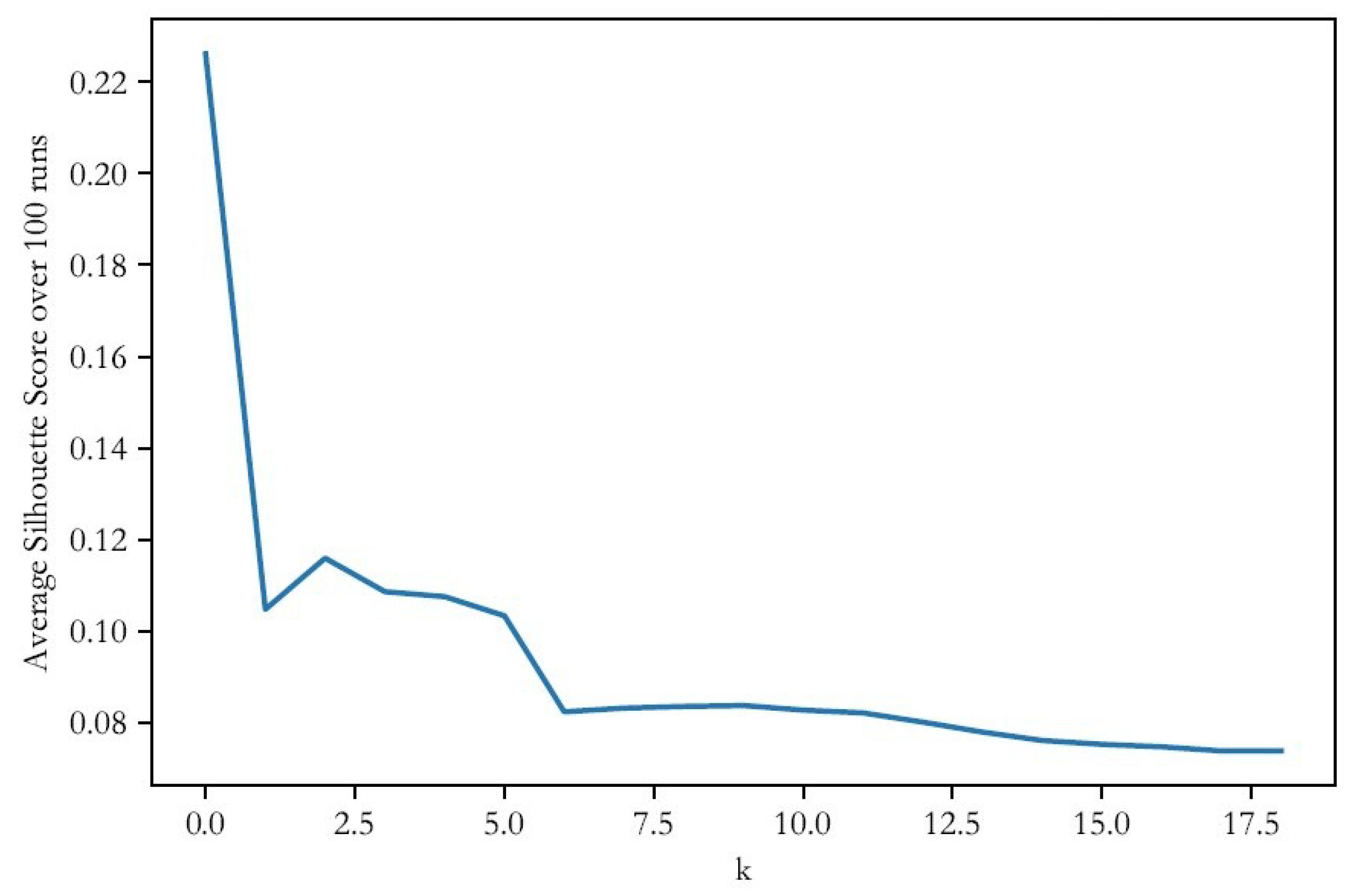
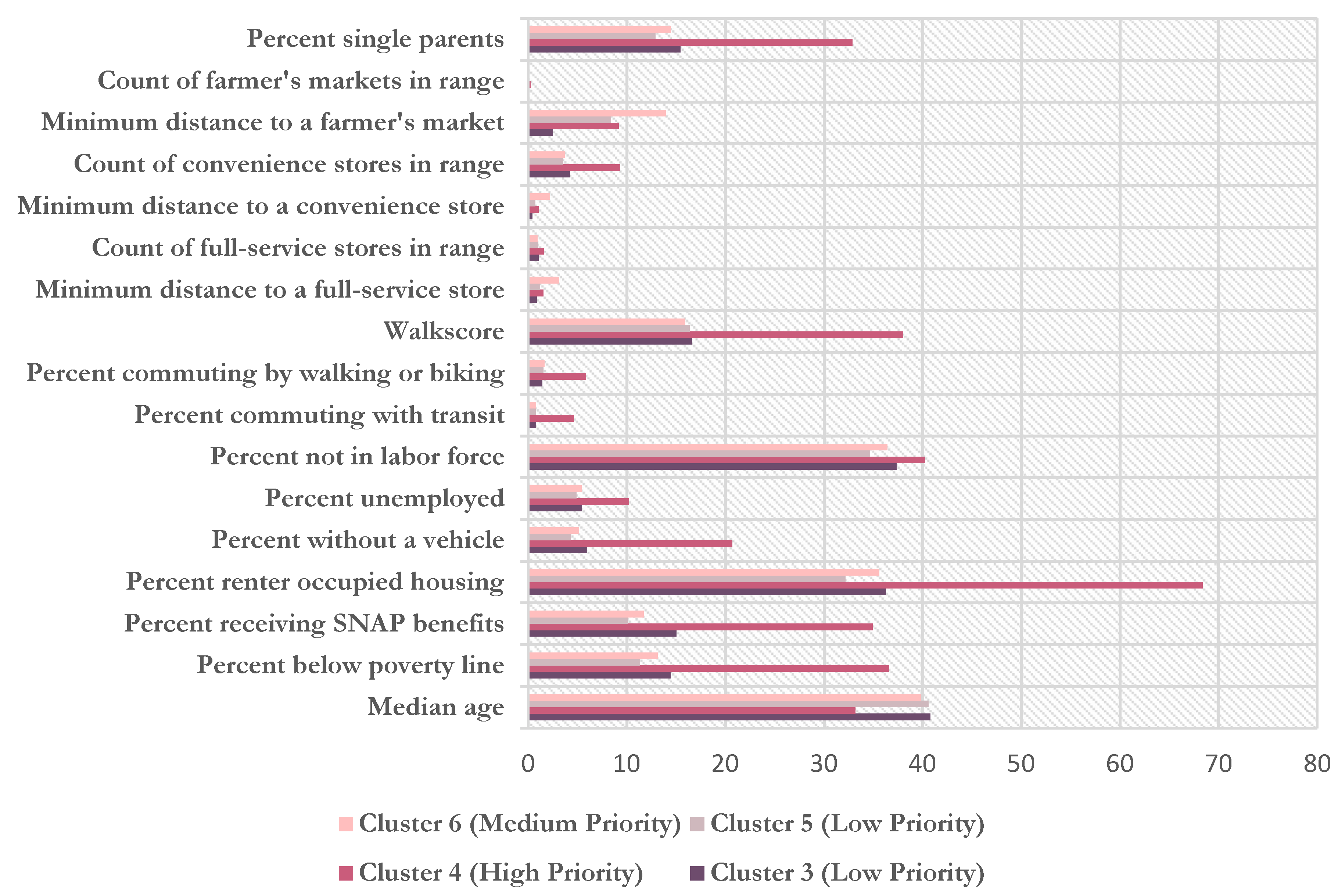
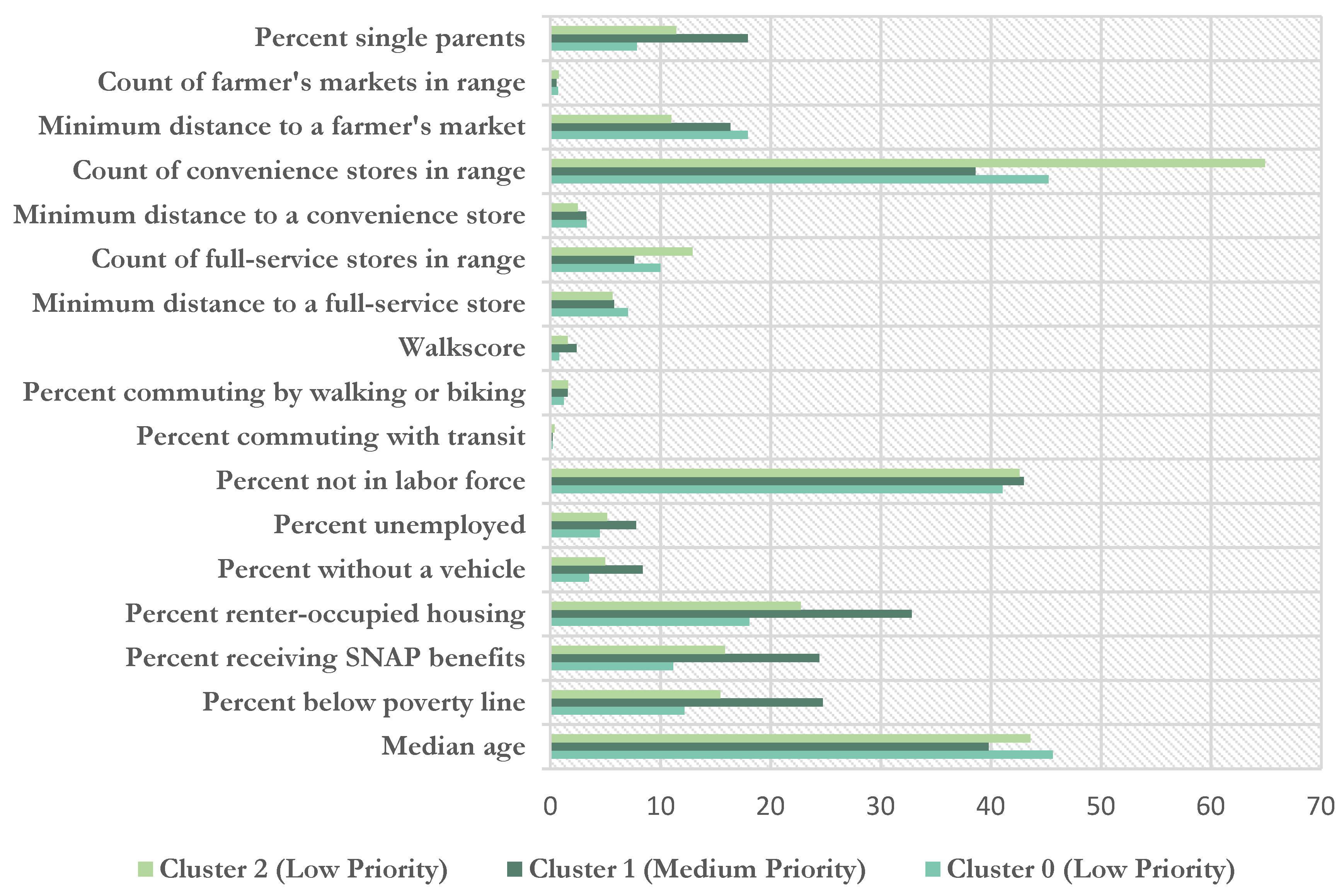
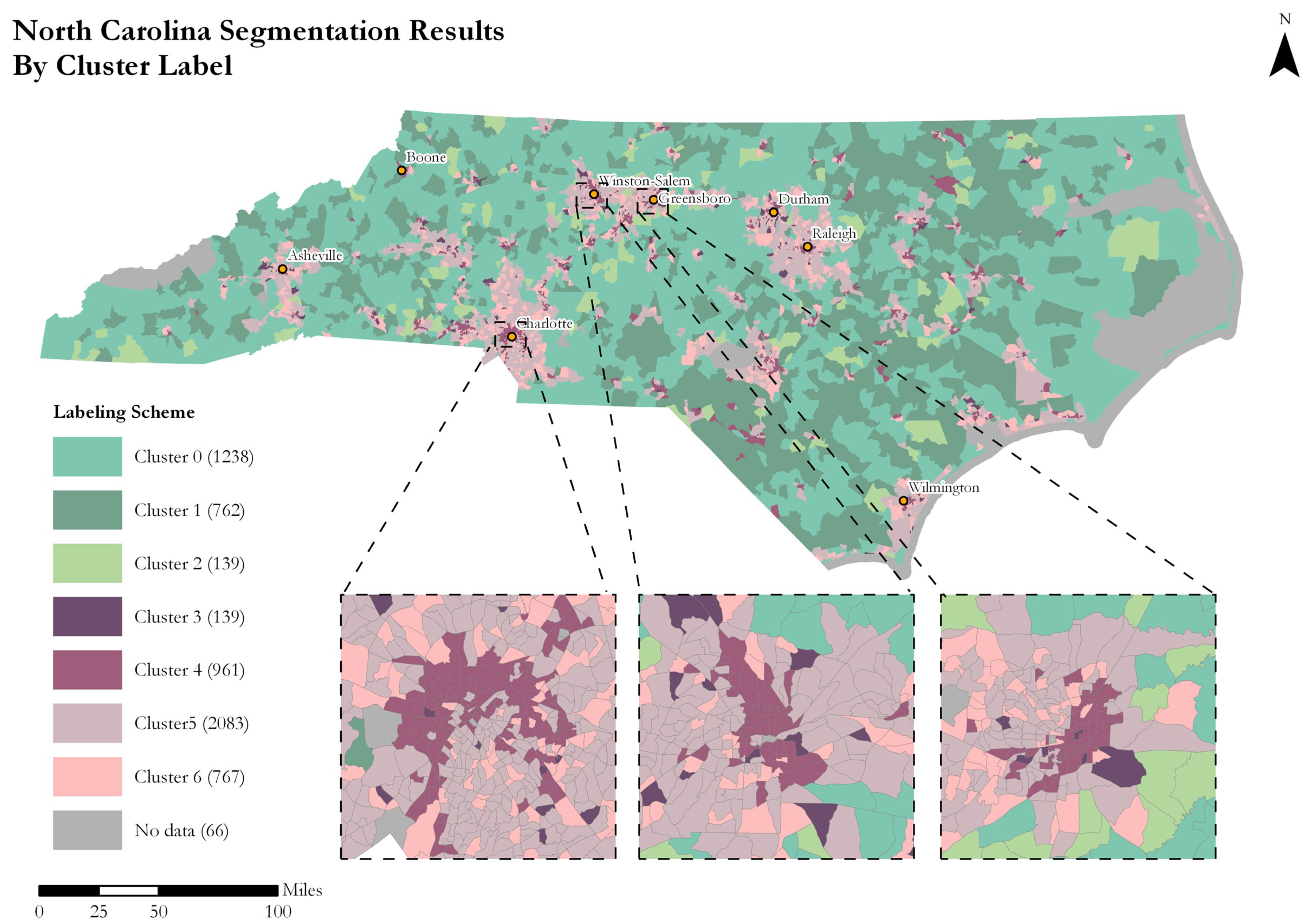


| Variable Name | Source | Used in Final? | Description |
|---|---|---|---|
| MedAge | ACS 2015 (US Census Bureau, Washington DC, USA, 2015) | Yes | Median age of block group (of total pop.) |
| MedIncome | Yes | Median income of block group (of total households) | |
| PcHHBelowPov | Yes | Percent of households below the federal poverty line | |
| PcHH60plus | No | Percent of households with a person over age 60 | |
| PcSNAPHH | Yes | Percent of households receiving SNAP benefits | |
| PcSNAPHHdisability | No | Percent of households receiving SNAP with a disabled person | |
| PcHHrentocc | Yes | Percent of households who rent their homes | |
| PcHHNoVehicle | Yes | Percent of households who do not own a car | |
| PcWhite | No | Percent of total population that identifies as white | |
| PcBlack | No | Percent of total population that identifies as black | |
| PcHisp | No | Percent of total population that identifies as Hispanic | |
| PcAsian | No | Percent of total population that identifies as Asian | |
| PcNatAm | No | Percent of total population that identifies as Native American | |
| PcTwoRaces | No | Percent of total population who identify themselves as belonging to two races | |
| PcUnemploy | Yes | Percent of work eligible persons (over age 16) who are unemployed | |
| PcNotInLabor | Yes | Percent of work eligible persons (over age 16) who are not in the workforce | |
| PcCommuteCar | No | Percent of workers who commute by car | |
| PcCommuteCP | No | Percent of workers who commute in a carpool | |
| PcWalkBike | Yes | Percent of workers who walk or bike to their job | |
| PcTransit | Yes | Percent of workers who commute via public transit | |
| PcSingPar | Yes | Percent of households with children that are headed by a single parent of any gender | |
| Walkscore | Walk Score™ (Washington, USA, 2007) | Yes | Index describing walkability of neighborhoods, on a 0–100 scale |
| Min_mqdist_fs | MapQuest (Colorado, USA, 1967) | Yes | Minimum distance from block group’s population-weighted centroid to a full-service grocery store |
| Min_mqdist_concom | Yes | Minimum distance from block group’s population-weighted centroid to a convenience store or combo grocery | |
| Min_mqdist_fm | Yes | Minimum distance from block group’s population-weighted centroid to a farmer’s market | |
| Count_pp_fs | Yes | Total number of full-service stores within USDA food deserts range, divided by total pop. | |
| Count_pp_concom | Yes | Total number of convenience stores/combo groceries within USDA food desert range, divided by total pop. | |
| Count_pp_fm | Yes | Total number of farmer’s markets within USDA food desert range, divided by total pop. |
| Variable | Metric | Cluster 0 n = 1238 | Cluster 1 n = 762 | Cluster 2 n = 139 |
|---|---|---|---|---|
| Median age | Average | 45.6222 | 39.7852 | 43.5741 |
| Standard Deviation | 7.1335 | 7.1066 | 7.4038 | |
| Percent below poverty line | Average | 12.1730 | 24.7355 | 15.4179 |
| Standard Deviation | 6.7422 | 9.0593 | 8.6482 | |
| Percent receiving SNAP benefits | Average | 11.1408 | 24.4011 | 15.8322 |
| Standard Deviation | 6.8400 | 10.1031 | 11.2097 | |
| Percent renter-occupied housing | Average | 18.0459 | 32.8212 | 22.7337 |
| Standard Deviation | 8.7674 | 11.1320 | 10.9185 | |
| Percent without a vehicle | Average | 3.5004 | 8.3587 | 4.9459 |
| Standard Deviation | 3.7080 | 6.5698 | 5.1283 | |
| Percent unemployed | Average | 4.4598 | 7.7809 | 5.1404 |
| Standard Deviation | 3.0318 | 4.7352 | 3.8901 | |
| Percent not in labor force | Average | 41.0416 | 42.9901 | 42.6050 |
| Standard Deviation | 10.0047 | 9.9739 | 10.2158 | |
| Percent commuting with transit | Average | 0.2047 | 0.2251 | 0.4108 |
| Standard Deviation | 0.9129 | 0.9991 | 2.0100 | |
| Percent commuting by walking or biking | Average | 1.2325 | 1.5924 | 1.6391 |
| Standard Deviation | 2.9092 | 3.3704 | 3.7216 | |
| Median income | Average | $44,229.78 | $41,258.28 | $40,265.20 |
| Standard Deviation | 24,712.32 | 20,285.45 | 14,684.70 | |
| Walkscore | Average | 0.8296 | 2.4108 | 1.5827 |
| Standard Deviation | 3.0493 | 7.3969 | 5.6897 | |
| Minimum distance to a full-service store | Average | 7.0337 | 5.7553 | 5.6433 |
| Standard Deviation | 4.7185 | 3.7983 | 3.0613 | |
| Count of full-service stores in range | Average | 9.9935 | 7.6024 | 12.8921 |
| Standard Deviation | 10.1896 | 7.5365 | 11.7036 | |
| Minimum distance to a convenience store | Average | 3.2766 | 3.2279 | 2.5184 |
| Standard Deviation | 2.4705 | 2.1410 | 1.5077 | |
| Count of convenience stores in range | Average | 45.2318 | 38.6076 | 64.8921 |
| Standard Deviation | 39.0225 | 31.7546 | 56.8120 | |
| Minimum distance to a farmer’s market | Average | 17.9316 | 16.3320 | 10.9763 |
| Standard Deviation | 12.3904 | 10.2971 | 5.8327 | |
| Count of farmer’s markets in range | Average | 0.7060 | 0.5801 | 0.7914 |
| Standard Deviation | 1.0645 | 0.8661 | 0.8689 | |
| Percent single parents | Average | 7.8368 | 17.9333 | 11.4207 |
| Standard Deviation | 6.2778 | 9.6056 | 9.0809 |
| Variable | Metric | Cluster 3 n = 139 | Cluster 4 n = 961 | Cluster 5 n = 2083 | Cluster 6 n = 767 |
|---|---|---|---|---|---|
| Median age | Average | 40.7928 | 33.1637 | 40.5831 | 39.8280 |
| Standard Deviation | 8.2748 | 8.2138 | 8.4934 | 9.3201 | |
| Percent below poverty line | Average | 14.4240 | 36.6012 | 11.3437 | 13.1438 |
| Standard Deviation | 11.3427 | 14.4803 | 8.4311 | 9.6833 | |
| Percent receiving SNAP benefits | Average | 15.0163 | 34.9327 | 10.1078 | 11.6977 |
| Standard Deviation | 14.8804 | 16.8864 | 8.8113 | 10.3026 | |
| Percent renter-occupied housing | Average | 36.2608 | 68.3857 | 32.1779 | 35.5951 |
| Standard Deviation | 23.0801 | 17.0172 | 20.3527 | 22.3081 | |
| Percent without a vehicle | Average | 5.9877 | 20.7033 | 4.3440 | 5.1724 |
| Standard Deviation | 6.3230 | 13.1125 | 4.8434 | 5.9454 | |
| Percent unemployed | Average | 5.4701 | 10.2192 | 4.9098 | 5.4216 |
| Standard Deviation | 4.0155 | 6.4191 | 3.5562 | 3.8776 | |
| Percent not in labor force | Average | 37.3674 | 40.2774 | 34.6687 | 36.4324 |
| Standard Deviation | 11.3758 | 13.4624 | 11.2841 | 12.4056 | |
| Percent commuting with transit | Average | 0.8092 | 4.6457 | 0.7550 | 0.8128 |
| Standard Deviation | 2.2915 | 7.1180 | 2.0540 | 2.3157 | |
| Percent commuting by walking or biking | Average | 1.4185 | 5.8811 | 1.5386 | 1.6616 |
| Standard Deviation | 2.8334 | 9.5058 | 3.4404 | 3.8422 | |
| Median income | Average | $51,608.18 | $47,538.04 | $51,040.18 | $50,699.21 |
| Standard Deviation | 26,604.81 | 27,103.28 | 28,406.72 | 27,928.46 | |
| Walkscore | Average | 16.6043 | 38.0187 | 16.3874 | 15.9387 |
| Standard Deviation | 17.9698 | 20.1399 | 17.6144 | 16.6794 | |
| Minimum distance to a full-service store | Average | 0.8806 | 1.5394 | 1.2000 | 3.1583 |
| Standard Deviation | 0.5567 | 0.9583 | 0.5673 | 1.4061 | |
| Count of full-service stores in range | Average | 1.0504 | 1.5963 | 1.0307 | 0.9622 |
| Standard Deviation | 1.1526 | 1.9967 | 1.2877 | 1.5821 | |
| Minimum distance to a convenience store | Average | 0.4393 | 1.0421 | 0.7356 | 2.2044 |
| Standard Deviation | 0.2736 | 0.7551 | 0.3998 | 1.1596 | |
| Count of convenience stores in range | Average | 4.2230 | 9.3413 | 3.5607 | 3.7106 |
| Standard Deviation | 4.3083 | 6.0916 | 3.9686 | 5.6612 | |
| Minimum distance to a farmer’s market | Average | 2.4976 | 9.1647 | 8.3929 | 13.9345 |
| Standard Deviation | 4.6527 | 8.5506 | 7.8369 | 12.2955 | |
| Count of farmer’s markets in range | Average | 0.0504 | 0.2539 | 0.0696 | 0.0443 |
| Standard Deviation | 0.3246 | 0.5966 | 0.2947 | 0.2616 | |
| Percent single parents | Average | 15.4316 | 32.8695 | 12.9241 | 14.4575 |
| Standard Deviation | 11.8546 | 17.3353 | 10.2853 | 11.5918 |
| Cluster Label | Classification | Priority Level | Total Area (mi2) | Area Overlap in mi2 (%) | |||
|---|---|---|---|---|---|---|---|
| LILA at 1 mi Urban, 10 mi Rural | LILA at 0.5 mi Urban, 10 mi Rural | LILA at 1 mi Urban, 20 mi Rural | LILA with Vehicle Access at 20 mi | ||||
| 0 | Rural | Low | 24,873.3 | 248.6 (1.0%) | 248.6 (1.0%) | 72.3 (0.3%) | 482.4 (1.94%) |
| 1 | Rural | Medium | 14,808.4 | 244.5 (1.7%) | 244.5 (1.7%) | 84.9 (0.6%) | 824.0 (5.56%) |
| 2 | Rural | Low | 2490.1 | 21.5 (0.9%) | 21.5 (0.9%) | 13.5 (0.5%) | 78.8 (3.2%) |
| 3 | Urban | Low | 255.4 | 20.6 (8.1%) | 29.4 (11.5%) | 20.6 (8.1%) | 21.4 (8.4%) |
| 4 | Urban | High | 913.9 | 199.5 (21.8%) | 350.2 (38.3%) | 199.5 (21.8%) | 295.6 (32.3%) |
| 5 | Urban | Low | 4607.6 | 281.0 (6.1%) | 365.6 (7.9%) | 281.0 (6.1%) | 234.1 (5.1%) |
| 6 | Urban | Medium | 1773.6 | 234.1 (13.2%) | 158.5 (8.9%) | 234.1 (13.2%) | 103.8 (5.9%) |
© 2018 by the authors. Licensee MDPI, Basel, Switzerland. This article is an open access article distributed under the terms and conditions of the Creative Commons Attribution (CC BY) license (http://creativecommons.org/licenses/by/4.0/).
Share and Cite
Major, E.; Delmelle, E.C.; Delmelle, E. SNAPScapes: Using Geodemographic Segmentation to Classify the Food Access Landscape. Urban Sci. 2018, 2, 71. https://doi.org/10.3390/urbansci2030071
Major E, Delmelle EC, Delmelle E. SNAPScapes: Using Geodemographic Segmentation to Classify the Food Access Landscape. Urban Science. 2018; 2(3):71. https://doi.org/10.3390/urbansci2030071
Chicago/Turabian StyleMajor, Elizabeth, Elizabeth C. Delmelle, and Eric Delmelle. 2018. "SNAPScapes: Using Geodemographic Segmentation to Classify the Food Access Landscape" Urban Science 2, no. 3: 71. https://doi.org/10.3390/urbansci2030071
APA StyleMajor, E., Delmelle, E. C., & Delmelle, E. (2018). SNAPScapes: Using Geodemographic Segmentation to Classify the Food Access Landscape. Urban Science, 2(3), 71. https://doi.org/10.3390/urbansci2030071






